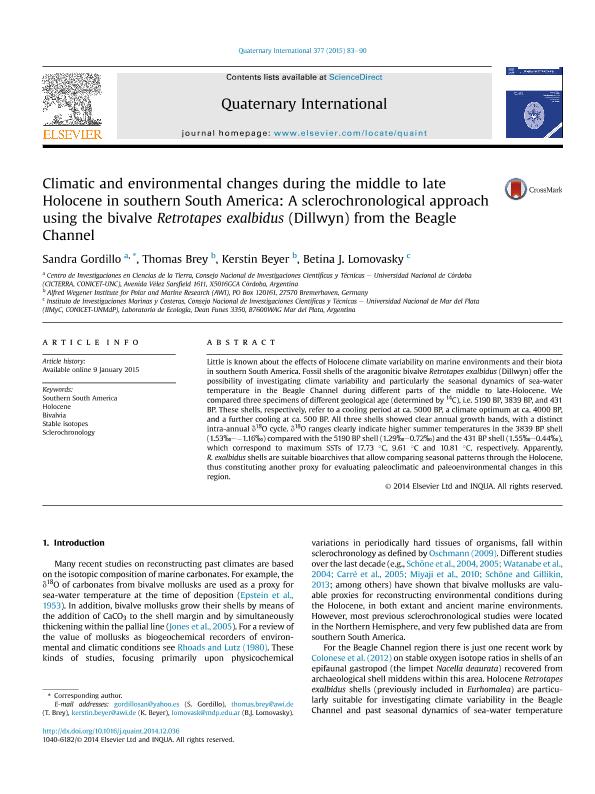Mostrar el registro sencillo del ítem
dc.contributor.author
Gordillo, Sandra

dc.contributor.author
Brey, Thomas
dc.contributor.author
Beyer, Kerstin
dc.contributor.author
Lomovasky, Betina Judith

dc.date.available
2018-02-28T18:42:35Z
dc.date.issued
2015-01
dc.identifier.citation
Gordillo, Sandra; Brey, Thomas; Beyer, Kerstin; Lomovasky, Betina Judith; Climatic and environmental changes during the middle to late Holocene in southern South America: A sclerochronological approach using the bivalve Retrotapes exalbidus (Dillwyn) from the Beagle channel; Pergamon-Elsevier Science Ltd; Quaternary International; 377; 1-2015; 83-90
dc.identifier.issn
1040-6182
dc.identifier.uri
http://hdl.handle.net/11336/37426
dc.description.abstract
Little is known about the effects of Holocene climate variability on marine environments and their biota in southern South America. Fossil shells of the aragonitic bivalve Retrotapes exalbidus (Dillwyn) offer the possibility of investigating climate variability and particularly the seasonal dynamics of sea-water temperature in the Beagle Channel during different parts of the middle to late-Holocene. We compared three specimens of different geological age (determined by 14C), i.e. 5190 BP, 3839 BP, and 431 BP. These shells, respectively, refer to a cooling period at ca. 5000 BP, a climate optimum at ca. 4000 BP, and a further cooling at ca. 500 BP. All three shells showed clear annual growth bands, with a distinct intra-annual δ18O cycle. δ18O ranges clearly indicate higher summer temperatures in the 3839 BP shell (1.53‰--1.16‰) compared with the 5190 BP shell (1.29‰-0.72‰) and the 431 BP shell (1.55‰-0.44‰), which correspond to maximum SSTs of 17.73 °C, 9.61 °C and 10.81 °C, respectively. Apparently, R. exalbidus shells are suitable bioarchives that allow comparing seasonal patterns through the Holocene, thus constituting another proxy for evaluating paleoclimatic and paleoenvironmental changes in this region.
dc.format
application/pdf
dc.language.iso
eng
dc.publisher
Pergamon-Elsevier Science Ltd

dc.rights
info:eu-repo/semantics/openAccess
dc.rights.uri
https://creativecommons.org/licenses/by-nc-nd/2.5/ar/
dc.subject
Bivalvia
dc.subject
Holocene
dc.subject
Sclerochronology
dc.subject
Southern South America
dc.subject
Stable Isotopes
dc.subject.classification
Meteorología y Ciencias Atmosféricas

dc.subject.classification
Ciencias de la Tierra y relacionadas con el Medio Ambiente

dc.subject.classification
CIENCIAS NATURALES Y EXACTAS

dc.title
Climatic and environmental changes during the middle to late Holocene in southern South America: A sclerochronological approach using the bivalve Retrotapes exalbidus (Dillwyn) from the Beagle channel
dc.type
info:eu-repo/semantics/article
dc.type
info:ar-repo/semantics/artículo
dc.type
info:eu-repo/semantics/publishedVersion
dc.date.updated
2018-02-28T14:28:13Z
dc.journal.volume
377
dc.journal.pagination
83-90
dc.journal.pais
Estados Unidos

dc.description.fil
Fil: Gordillo, Sandra. Consejo Nacional de Investigaciones Científicas y Técnicas. Centro Científico Tecnológico Conicet - Córdoba. Centro de Investigaciones en Ciencias de la Tierra. Universidad Nacional de Córdoba. Facultad de Ciencias Exactas Físicas y Naturales. Centro de Investigaciones en Ciencias de la Tierra; Argentina
dc.description.fil
Fil: Brey, Thomas. Alfred Wegener Institute for Polar and Marine Research; Alemania
dc.description.fil
Fil: Beyer, Kerstin. Alfred Wegener Institute for Polar and Marine Research; Alemania
dc.description.fil
Fil: Lomovasky, Betina Judith. Consejo Nacional de Investigaciones Científicas y Técnicas. Centro Científico Tecnológico Conicet - Mar del Plata. Instituto de Investigaciones Marinas y Costeras. Universidad Nacional de Mar del Plata. Facultad de Ciencia Exactas y Naturales. Instituto de Investigaciones Marinas y Costeras; Argentina
dc.journal.title
Quaternary International

dc.relation.alternativeid
info:eu-repo/semantics/altIdentifier/doi/http://dx.doi.org/10.1016/j.quaint.2014.12.036
dc.relation.alternativeid
info:eu-repo/semantics/altIdentifier/url/https://www.sciencedirect.com/science/article/pii/S1040618214009914
Archivos asociados
